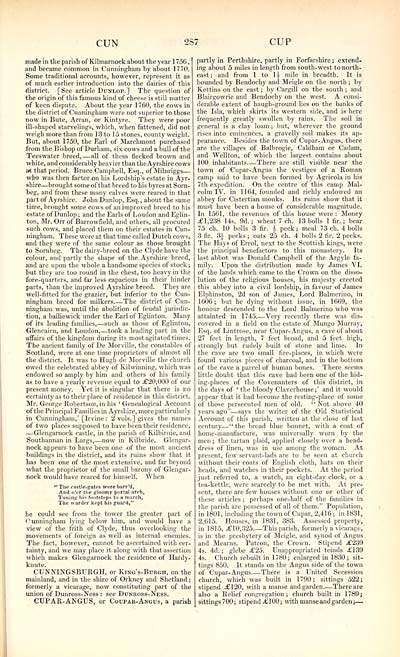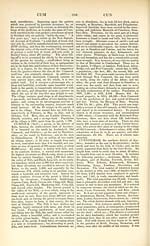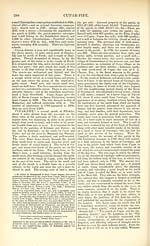Topographical, statistical, and historical gazetteer of Scotland > Volume 1
(369) Page 287 - CUN
Download files
Complete book:
Individual page:
Thumbnail gallery: Grid view | List view

CUN
2S7
CUP
made in the parish of Kilmarnock about the year 1 756 ,
and became common in Cunningham by about 1770.
Some traditional accounts, however, represent it as
of much earlier introduction into the dairies of this
district. [See article Dunlop.] The question of
the origin of this famous kind of cheese is still matter
of keen dispute. About the year 1760, the cows in
the district of Cunningham were not superior to those
now in Bute, Arran, or Kintyre. They were poor
ill-shaped starvelings, which, when fattened, did not
weigh more than from 13 to 15 stones, county weight.
But, about 1750, the Earl of Marchmont purchased
from the Bishop of Durham, six cows and a bull of the
Teeswater breed, — all of them flecked brown and
white, and considerably heavier than the Ayrshire cows
at that period. Bruce Campbell, Esq., of Milnriggs —
who was then factor on his Lordship's estate in Ayr-
shire — brought some of that breed to his byres at Sorn-
beg, and from these many calves were reared in that
part of Ayrshire. John Dunlop, Esq., about the same
time, brought some cows of an improved breed to his
estate of Dunlop ; and the Earls of Loudon and Eglin-
ton, Mr. Orr of Barrowfield, and others, all procured
such cows, and placed them on their estates in Cun-
ningham. These were at that time called Dutch cows,
and they were of the same colour as those brought
to Sornbeg. The dairy-breed on the Clyde have the
colour, and partly the shape of the Ayrshire breed,
and are upon the whole a handsome species of stock ;
but they are too round in the chest, too heavy in the
fore-quarters, and far less capacious in their hinder
parts, than the improved Ayrshire breed. They are
well-fitted for the grazier, but inferior to the Cun-
ningham breed for milkers The district of Cun-
ningham was, until the abolition of feudal jurisdic-
tion, a bailiewick under the Earl of Eglinton. Many
of its leading families, — such as those of Eglinton,
Glencairn, and Loudon, — took a leading part in the
affairs of the kingdom during its most agitated times.
The ancient family of De Morville, the constables of
Scotland, were at one time proprietors of almost all
the district. It was to Hugh de Morville the church
owed the celebrated abbey of Kilwinning, which was
endowed so amply by him and others of his family
as to have a yearly revenue equal to .£20,000 of our
present money. Yet it is singular that there is no
certainty as to their place of residence in this district.
Mr. George Robertson, in his ' Genealogical Account
of the Principal Families in Ayrshire, more particularly
in Cunningham,' [Irvine : 2 vols.] gives the names
of two places supposed to have been their residence,
. — Glengarnock castle, in the parish of Kilbirnie, and
Southannan in Largs, — now in Kilbride. Glengar-
nock appears to have been one of the most ancient
buildings in the district, and its ruins show that it
has been one of the most extensive, and far beyond
what the proprietor of the small barony of Glengar-
nock would have reared for himself. When
"The castle-gates were barr'd,
And o'er the gloomy portal arch,
Tuning his footsteps to a march,
The warder kept his guard,"
he could see from the tower the greater part of
Cunningham lying below him, and would have a
view of the frith of Clyde, thus overlooking the
movements of foreign as well as internal enemies.
The fact, however, cannot be ascertained with cer-
tainty, and we may place it along with that assertion
which makes Glengarnock the residence of Hardy-
knute.
CUNNINGSBURGH, or King's-Burgh, on the
mainland, and in the shire of Orkney and Shetland ;
formerly a vicarage, now constituting part of the
union of Dunross-Ness : see Dunross-Ness.
CUPAR-ANGUS, or Coupar-Angus, a parish
partly in Perthshire, partly in Forfarshire ; extend-
ing about 5 miles in length from south-west to north-
east; and from 1 to li mile in breadth. It is
bounded by Bendochy and Meigle on the north ; by
Kettins on the east ; by Cargill on the south ; and
Blairgowrie and Bendochy on the west. A consi-
derable extent of haugh-ground lies on the banks of
the Isla, which skirts its western side, and is here
frequently greatly swollen by rains. The soil in
general is a clay loam ; but, wherever the ground
rises into eminences, a gravelly soil makes its ap-
pearance. Besides the town of Cupar- Angus, there
are the villages of Balbrogie, Caldham or Cadam,
and Wellton, of which the largest contains about
100 inhabitants There are still visible near the
town of Cupar-Angus the vestiges of a Roman
camp said to have been formed by Agricola in his
7th expedition. On the centre of this camp Mal-
colm IV. in 1164, founded and richly endowed an
abbey for Cistertian monks. Its ruins show that it
must have been a house of considerable magnitude.
In 1561, the revenues of this house were : Money
£1,238 14s. 9d. ; wheat 7 ch. 13 bolls 1 fir. ; bear
75 ch. 10 bolls 3 fir. i peck ; meal 73 ch. 4 bolls
3 fir. 3| pecks ; oats 25 ch. 4 bolls 2 fir. 2 pecks.
The Hays of Errol, next to the Scottish kings, were
the principal benefactors to this monastery. Its
last abbot was Donald Campbell of the Argyle fa-
mily. Upon the distribution made by James VI.
of the lands which came to the Crown on the disso-
lution of the religious houses, his majesty erected
this abbey into a civil lordship, in favour of James
Elphinston, 2d son of James, Lord Balmerino, in
1606 ; but he dying without issue, in 1669, the
honour descended to the Lord Balmerino who was
attainted in 1745 Very recently there was dis-
covered in a field on the estate of Mungo Murray,
Esq. of Lintrose, near Cupar- Angus, a cave of about
27 feet in length, 7 feet broad, and 5 feet high,
strongly but rudely built of stone and lime. In
the cave are two small fire-places, in which were
found various pieces of charcoal, and in the bottom
of the cave a parcel of human bones. There seems
little doubt that this cave had been one of the hid-
ing-places of the Covenanters of this district, in
the days of ' the bloody Claverhouse;' and it would
appear that it had become the resting-place of some
of those persecuted men of old. " Not above 40
years ago" — says the writer of the Old Statistical
Account of this parish, written at the close of last
century — "the broad blue bonnet, with a coat of
home-manufacture, was universally worn by the
men; the tartan plaid, applied closely over a head-
dress of linen, was in use among the women. At
present, few servant-lads are to be seen at church
without their coats of English cloth, hats on their
heads, and watches in their pockets. At the period
just referred to, a watch, an eight-day clock, or a
tea-kettle, were scarcely to be met with. At pre-
sent, there are few houses without one or other of
these articles ; perhaps one-half of the families in
the parish are possessed of all of them." Population,
in 1801, including the town of Cupar, 2,416 ; in 1831,
2,615. Houses, in 1831, 383. Assessed property,
in 1815, £10,325 This parish, formerly a vicarage,
is in the presbytery of Meigle, and synod of Angus
and Mearns. Patron, the Crown. Stipend £239
4s. 4d. ; glebe £25. Unappropriated teinds £139
4s. Church rebuilt in 1780; enlarged in 1830 ; sit-
tings 850. It stands on the Angus side of the town
of Cupar-Angus There is a United Secession
church, which was built in 1790; sittings 522;
stipend £120, with a manse and garden There are
also a Relief congregation ; church built in 1 789 ;
sittings 700; stipend £100; with manse and garden j—
2S7
CUP
made in the parish of Kilmarnock about the year 1 756 ,
and became common in Cunningham by about 1770.
Some traditional accounts, however, represent it as
of much earlier introduction into the dairies of this
district. [See article Dunlop.] The question of
the origin of this famous kind of cheese is still matter
of keen dispute. About the year 1760, the cows in
the district of Cunningham were not superior to those
now in Bute, Arran, or Kintyre. They were poor
ill-shaped starvelings, which, when fattened, did not
weigh more than from 13 to 15 stones, county weight.
But, about 1750, the Earl of Marchmont purchased
from the Bishop of Durham, six cows and a bull of the
Teeswater breed, — all of them flecked brown and
white, and considerably heavier than the Ayrshire cows
at that period. Bruce Campbell, Esq., of Milnriggs —
who was then factor on his Lordship's estate in Ayr-
shire — brought some of that breed to his byres at Sorn-
beg, and from these many calves were reared in that
part of Ayrshire. John Dunlop, Esq., about the same
time, brought some cows of an improved breed to his
estate of Dunlop ; and the Earls of Loudon and Eglin-
ton, Mr. Orr of Barrowfield, and others, all procured
such cows, and placed them on their estates in Cun-
ningham. These were at that time called Dutch cows,
and they were of the same colour as those brought
to Sornbeg. The dairy-breed on the Clyde have the
colour, and partly the shape of the Ayrshire breed,
and are upon the whole a handsome species of stock ;
but they are too round in the chest, too heavy in the
fore-quarters, and far less capacious in their hinder
parts, than the improved Ayrshire breed. They are
well-fitted for the grazier, but inferior to the Cun-
ningham breed for milkers The district of Cun-
ningham was, until the abolition of feudal jurisdic-
tion, a bailiewick under the Earl of Eglinton. Many
of its leading families, — such as those of Eglinton,
Glencairn, and Loudon, — took a leading part in the
affairs of the kingdom during its most agitated times.
The ancient family of De Morville, the constables of
Scotland, were at one time proprietors of almost all
the district. It was to Hugh de Morville the church
owed the celebrated abbey of Kilwinning, which was
endowed so amply by him and others of his family
as to have a yearly revenue equal to .£20,000 of our
present money. Yet it is singular that there is no
certainty as to their place of residence in this district.
Mr. George Robertson, in his ' Genealogical Account
of the Principal Families in Ayrshire, more particularly
in Cunningham,' [Irvine : 2 vols.] gives the names
of two places supposed to have been their residence,
. — Glengarnock castle, in the parish of Kilbirnie, and
Southannan in Largs, — now in Kilbride. Glengar-
nock appears to have been one of the most ancient
buildings in the district, and its ruins show that it
has been one of the most extensive, and far beyond
what the proprietor of the small barony of Glengar-
nock would have reared for himself. When
"The castle-gates were barr'd,
And o'er the gloomy portal arch,
Tuning his footsteps to a march,
The warder kept his guard,"
he could see from the tower the greater part of
Cunningham lying below him, and would have a
view of the frith of Clyde, thus overlooking the
movements of foreign as well as internal enemies.
The fact, however, cannot be ascertained with cer-
tainty, and we may place it along with that assertion
which makes Glengarnock the residence of Hardy-
knute.
CUNNINGSBURGH, or King's-Burgh, on the
mainland, and in the shire of Orkney and Shetland ;
formerly a vicarage, now constituting part of the
union of Dunross-Ness : see Dunross-Ness.
CUPAR-ANGUS, or Coupar-Angus, a parish
partly in Perthshire, partly in Forfarshire ; extend-
ing about 5 miles in length from south-west to north-
east; and from 1 to li mile in breadth. It is
bounded by Bendochy and Meigle on the north ; by
Kettins on the east ; by Cargill on the south ; and
Blairgowrie and Bendochy on the west. A consi-
derable extent of haugh-ground lies on the banks of
the Isla, which skirts its western side, and is here
frequently greatly swollen by rains. The soil in
general is a clay loam ; but, wherever the ground
rises into eminences, a gravelly soil makes its ap-
pearance. Besides the town of Cupar- Angus, there
are the villages of Balbrogie, Caldham or Cadam,
and Wellton, of which the largest contains about
100 inhabitants There are still visible near the
town of Cupar-Angus the vestiges of a Roman
camp said to have been formed by Agricola in his
7th expedition. On the centre of this camp Mal-
colm IV. in 1164, founded and richly endowed an
abbey for Cistertian monks. Its ruins show that it
must have been a house of considerable magnitude.
In 1561, the revenues of this house were : Money
£1,238 14s. 9d. ; wheat 7 ch. 13 bolls 1 fir. ; bear
75 ch. 10 bolls 3 fir. i peck ; meal 73 ch. 4 bolls
3 fir. 3| pecks ; oats 25 ch. 4 bolls 2 fir. 2 pecks.
The Hays of Errol, next to the Scottish kings, were
the principal benefactors to this monastery. Its
last abbot was Donald Campbell of the Argyle fa-
mily. Upon the distribution made by James VI.
of the lands which came to the Crown on the disso-
lution of the religious houses, his majesty erected
this abbey into a civil lordship, in favour of James
Elphinston, 2d son of James, Lord Balmerino, in
1606 ; but he dying without issue, in 1669, the
honour descended to the Lord Balmerino who was
attainted in 1745 Very recently there was dis-
covered in a field on the estate of Mungo Murray,
Esq. of Lintrose, near Cupar- Angus, a cave of about
27 feet in length, 7 feet broad, and 5 feet high,
strongly but rudely built of stone and lime. In
the cave are two small fire-places, in which were
found various pieces of charcoal, and in the bottom
of the cave a parcel of human bones. There seems
little doubt that this cave had been one of the hid-
ing-places of the Covenanters of this district, in
the days of ' the bloody Claverhouse;' and it would
appear that it had become the resting-place of some
of those persecuted men of old. " Not above 40
years ago" — says the writer of the Old Statistical
Account of this parish, written at the close of last
century — "the broad blue bonnet, with a coat of
home-manufacture, was universally worn by the
men; the tartan plaid, applied closely over a head-
dress of linen, was in use among the women. At
present, few servant-lads are to be seen at church
without their coats of English cloth, hats on their
heads, and watches in their pockets. At the period
just referred to, a watch, an eight-day clock, or a
tea-kettle, were scarcely to be met with. At pre-
sent, there are few houses without one or other of
these articles ; perhaps one-half of the families in
the parish are possessed of all of them." Population,
in 1801, including the town of Cupar, 2,416 ; in 1831,
2,615. Houses, in 1831, 383. Assessed property,
in 1815, £10,325 This parish, formerly a vicarage,
is in the presbytery of Meigle, and synod of Angus
and Mearns. Patron, the Crown. Stipend £239
4s. 4d. ; glebe £25. Unappropriated teinds £139
4s. Church rebuilt in 1780; enlarged in 1830 ; sit-
tings 850. It stands on the Angus side of the town
of Cupar-Angus There is a United Secession
church, which was built in 1790; sittings 522;
stipend £120, with a manse and garden There are
also a Relief congregation ; church built in 1 789 ;
sittings 700; stipend £100; with manse and garden j—
Set display mode to: Large image | Transcription
Images and transcriptions on this page, including medium image downloads, may be used under the Creative Commons Attribution 4.0 International Licence unless otherwise stated. ![]()
| Gazetteers of Scotland, 1803-1901 > Topographical, statistical, and historical gazetteer of Scotland > Volume 1 > (369) Page 287 - CUN |
|---|
| Permanent URL | https://digital.nls.uk/97441974 |
|---|
| Description | Volume first. A-H. |
|---|---|
| Attribution and copyright: |
|

